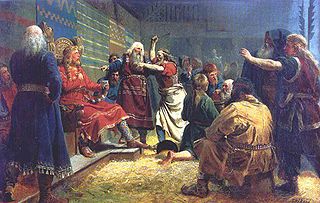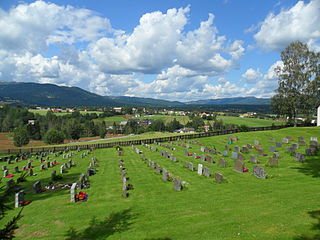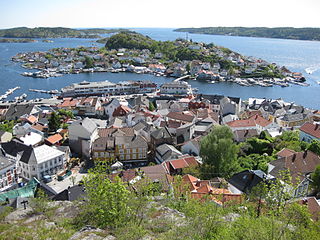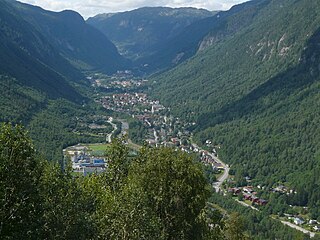
Haakon Haraldsson, also Haakon the Good and Haakon Adalsteinfostre, was the king of Norway from 934 to 961. He was noted for his attempts to introduce Christianity into Norway.

Bø is a former municipality in Telemark county, Norway. It was part of the traditional region of Midt-Telemark, but was historically regarded as part of Grenland. The 263-square-kilometre (102 sq mi) municipality existed from 1838 until its dissolution in 2020. The area is now part of Midt-Telemark Municipality. The administrative centre was the village of Bø i Telemark. Other villages in the municipality included Folkestad and Nordbøåsane.

Kragerø is a municipality in Telemark county, Norway. It is located in the traditional districts of Grenland and the smaller Vestmar. The administrative centre of the municipality is the town of Kragerø. Villages in Kragerø include Helle, Vadfoss, Kil, and Portør.

is a municipality in Telemark county, Norway. It is located in the traditional district of Aust-Telemark. The administrative centre of the municipality is the town of Notodden. Other population centres include the villages of Bolkesjø, Gransherad, Heddal, Hjuksebø, Hjuksevelta, Rudsgrendi, Tinnoset, and Yli.

Tinn is a municipality in Telemark county, Norway. It is located in the traditional districts of Aust-Telemark and Upper Telemark. The administrative centre of the municipality is the town of Rjukan. Some of the villages in Tinn include Atrå, Austbygde, Hovin, and Miland.

Gudrød the Hunter, also known as Gudrød the Magnificent, is a legendary character portrayed in the Norse sagas as a Norwegian petty king in the early 9th century. According to the sagas, he was the father of Halfdan the Black, and thus the grandfather of Harald Fairhair, the first king of unified Norway. He is considered by modern historians to be of a more mythical nature than other ancestors of Harald and Halfdan, and he can not be identified historically. Historians have in turn made a number of proposals seeking to identify him with various would-be contemporary historical figures.

The Bagli Party or Bagler was a faction or party during the Norwegian Civil Wars. The Bagler faction was made up principally of the Norwegian aristocracy, clergy and merchants.
The Battle of Storsjön was fought during 1178 outside Sunne, in Jämtland province, Sweden. The battle was won by the Birkebeiner army of King Sverre of Norway.

Tore Pryser is a Norwegian historian who has served as professor at the Lillehammer University College since 1993.
Arnved Nedkvitne is a Norwegian historian of the Middle Ages and Professor Emeritus of mediaeval history. He held the chair of Norwegian mediaeval history at the University of Trondheim from 1991 to 1993 and at the University of Oslo from 1993 to 2009. He is a member of the Royal Norwegian Society of Sciences and Letters, and was elected in 1993. Nedkvitne is regarded as "one of Norway's preeminent commercial historians" and as Norway's foremost mediaeval historian. His research has focused on Norwegian urban history, foreign trade, the economy of coastal communities and pre-modern social organisation. He is the foremost scholar of the relations between the Hanseatic League and Norway; his research has also explored topics such as honour, law and religious ethics in Scandinavia, the social consequences of literacy in the Middle Ages, lay beliefs of mediaeval Scandinavia, and the Norse settlement of Arctic Greenland.

Trond Bergh is a Norwegian economic historian, and researcher at the Department of Innovation and Economic Organisation of the BI Norwegian Business School.
Gunnar Christie Wasberg was a Norwegian historian, philosopher and first librarian at the University of Oslo Library.
The First Battle of Solskjel was the first engagement in Harald Fairhair's attempt to subjugate western Norway to his rule.

The Unification of Norway is the process by which Norway merged from several petty kingdoms into a single kingdom, predecessor to the modern Kingdom of Norway.

Alexander Bugge was a Norwegian historian. He was professor at the Royal Frederick University from 1903–1912, and his main fields of interest were culture and society in the Viking era and the development of trade and cities in Norway during the Middle Ages.

Passio Olavi, more correctly Passio a miracule beati Olavi is a collection of legends about the Norwegian national saint Olaf II the Holy. The text was probably collected while Eysteinn Erlendsson was Archbishop of Nidaros (1159-1188), and is possibly written by Eysteinn himself. Egil Kraggerud dated the Passio Olavi to ca. 1150–1160.

Bi Skaarup was a Danish archeologist, author, food historian and lecturer. She was employed at Museum of Copenhagen from 1985 to 2006 as curator, and was responsible for parts of the excavations during the construction of Copenhagen Metro and wrote several articles about the subjects.

Old Kviteseid Church is a parish church of the Church of Norway in Kviteseid Municipality in Vestfold og Telemark county, Norway. It is located about 4 kilometres (2.5 mi) north of the village of Eidstod. It is one of the churches in the Kviteseid parish which is part of the Øvre Telemark prosti (deanery) in the Diocese of Agder og Telemark. The white, stone church was built in a long church design around the year 1260 using plans drawn up by an unknown architect. The church seats about 150 people. This is among the better preserved stone churches in Telemark.

Lily Weiser-Aall, born Elisabeth Augusta Jeanette Weiser, was an Austrian philologist and ethnologist who specialized in Germanic studies.

Loft is a traditional two-storey wooden building preserved mostly in Norway. A loft was used for storage and sleeping, and is known since the early Middle Ages. Loft buildings dating from around 1200 are preserved in rural areas. Lofts were typically built in log technique, unlike the post and lintel construction in stave churches. Many lofts have an external corridor or balcony resting on a log corbel. The oldest non-religious wooden buildings in Norway are lofts. In addition to the stave church, Christian Norberg-Schulz regards the loft as Norway's most important contribution to history of architecture.















